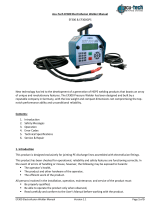70 ORION FITTINGS, INC. Acid Waste Piping Systems
Acid Waste Assembly Socket Fusion
A socket fusion tool kit, including heat tool and various sizes of heads
is available from Orion.
Note:
• Make all field cuts of pipe square and true using a pipe cutter
designed for plastic pipe.
• Make certain heads are installed properly on heat tool. Heads
are marked “M” and “F”, indicating male and female.
• Bevel the leading edge of each pipe section with a 1/8” 45 degree
chamfer. This will minimize the amount of bead on the inside of the
fitting when fused
STEP 2
Measure depth of fitting. Subtract
1
/
16
".
STEP 3
Transfer measurement to pipe. Mark pipe with measurement
obtained in Step 2.
3
1
4
STEP 1
Check the heads for proper temperature (482 - 520°F or 250°- 270°C ). If
necessary, adjust the thermostat dial so that the 488°F Tempil stick burns,
but the 525°F does not. NOTE: The newest Orion fusion tools may
have a temperature dial in degrees celcius which has a maximum
temperature of 300°C. If this is the case, see temperature conversion
chart below. Heat tools are factory set, however settings can vary due to
factors such as weather, current variances, cord lengths, generators, etc.
These variables should be checked on site. To increase tool
temperature, turn dial “in” (clockwise). To decrease, turn screw “out”
(counterclockwise).
Step 6
Hold joint under pressure for 15 seconds to allow surfaces to
fuse. Do not stress joint until fully cooled.
Clean any melted material from heater bushings using a cotton
rag. Do not use abrasive materials to clean the heater bushings.
Confirm the heater bushings are the correct temperature before
fusing next joint.
The following chart shows the approximate time that the pipe
and fitting should be held on the heater bushings. These times
are a guideline ony. It may be necessary to increase or
decrease times to obtain the correct melt
conditions.
2
6
1-1/2” 2” 3” 4” 6”
PP 12-15 sec 15-20 sec 20-25 sec 25-30 sec 30-35 sec
PVDF 12-15 sec 15-20 sec 20-25 sec 25-30 sec 30-35 sec
STEP 4
Insert fitting on the male side of the heat tool. Then insert
pipe on the female side. Do not insert past the mark on
the pipe.
Fusion Times in seconds
STEP 5
Keep pipe and fitting absolutely straight on heat tool.
Use the chart below to determine how long to leave the pipe and
fittings on the heater bushings.It should be noted that pipe and
fittings will normally have a slight interference with the fusion
tools. However, if the pipe and/or fittings do not fit tightly on the
heater bushing, the heating time should be started when the
components have swelled to just contact the surface of the
bushing.
NOTE: DO NOT TEST
NOTE: DO NOT TEST
ANY
ANY
ORION PIPING SYSTEM WITH COMPRESSED
ORION PIPING SYSTEM WITH COMPRESSED
AIR OR GASSES.
AIR OR GASSES.
TEST HYDROST
TEST HYDROST
A
A
TICALL
TICALL
Y
Y
ONL
ONL
Y
Y
Temperature Conversion Factors
°F = Degrees in Farenheight
°C = Degrees in Celcius(Centigrade)
°F = (°C x 1.8) + 32
°C= (°F - 32) x .555
°F °C
122 50
212 100
300 150
392 200
482 250
520 270
572 300




